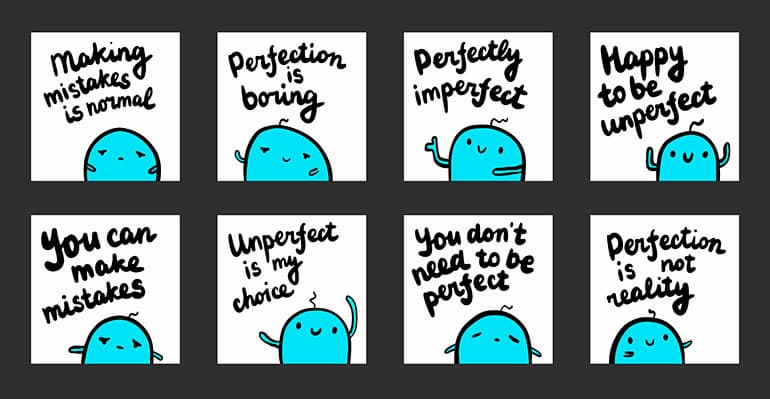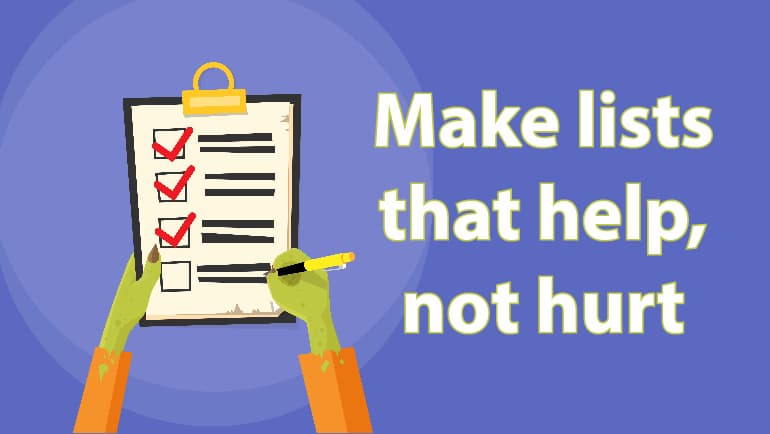Make a list of all the things you need to do today.
Consult the list 52 times to make sure that you know what you need to be doing. Sigh heavily when you realize you didn’t complete nearly enough things and now must move 47 items to your tomorrow list.
Sound familiar? You’re not alone.
I’ve always been a list maker. On post-it notes. In a notebook. On scraps of paper. In my head.
I’ve used digital list makers that sync between my devices. To-do lists on my calendars. Color-coded lists. Tabbed lists. You name it, I’ve probably tried it.
To this day, I cannot commit to one way of list-making. I am constantly trying to figure out the system that will stick! In all the trying, I’ve learned a few things.
List-making can help relieve stress
For starters, I’ve learned that I make more lists when I’m experiencing a lot of stress and anxiety. That’s because a list can actually help you feel better, writes Elizabeth Schacht, a nurse practitioner from the University of Iowa’s Medical Student Counseling Center. “Research shows that having a plan decreases anxiety. This results in feeling less overwhelmed, with (an) increased sense of control.”
I find that list-making liberates the scattered and persistent things that rattle around in my thoughts. Getting them on paper allows my mind to let go of them.
So I make what I call my Brain Dump List. It’s a running list of every task I need to get done — whether it’s picking up something at the grocery store or submitting a report.
I’ve also learned I become overwhelmed when I have too many items on my list. Yet, I can’t just not put something on my to-do list, because that would also make me anxious!
Prioritize, set deadlines, break larger tasks into smaller ones to make lists useful
To help my lists be as useful as possible, I follow these basic guidelines:
• Prioritize. I follow a system from Pearson Languages that categorizes my tasks: what needs to get done now (important and urgent), what can wait a little bit (important but not urgent), and things that would be nice to eventually get to (not urgent and not important). Through this process, things move from my Brain Dump List to my To-Do List of what I’m currently working on.
• Set due dates. “To-do lists without deadlines are wish lists,” says physicist Younes Henni, writing for Medium. So, I TRY to set honest and realistic deadlines. Actually, I set two: a “soft” deadline (suggested or aspirational), and a “hard” deadline (by which something must be completed). Soft deadlines give me wiggle room; hard deadlines are ones I MUST meet.
• Break larger tasks down to smaller tasks. I don’t know about you, but when I’m faced with a large task, I can easily start to feel overwhelmed and defeated. I freeze up. When I break things down into smaller, digestible pieces, I find what professional life coach Todd Snyder calls a “recommended ‘hack’ ” to get dopamine flowing. “Each time you check off something on your list, you get a little motivational jolt of dopamine released in your brain. As a result, it takes less willpower to get things done.”

How to handle perfectionism, fear of failure
For all the good of list-making, some things can happen when you combine it with”neuro-spicy” brains like mine.
Perfectionism can be a challenge. What happens when your lists aren’t spaced correctly or written perfectly? Or if your fifth checkbox is different than the rest? You might be like me, crumple up that list, throw it away, and start over. This is where a digital list can come in handy. You can’t crumple it up — but you can move things around and format to your heart’s content!
Sometimes, a list can turn into a source of failure, says writer and nonprofit worker Henah Velez in The Good Trade. “Needing to complete my to-do list brings out my inner perfectionist and the feeling that I must ‘do it all.’ When I don’t, the feeling quickly transitions into, ‘You didn’t get what you needed done and now you’re perpetually behind,’ or even worse, ‘You’re lazy.’ ”
That’s why it’s important not to put too many things on your list, and lean on the side of over-estimating time for a task rather than under-estimating. You also need to give yourself grace for not finishing everything on your list.
Only after I really thought about my list-making habits did I understand how they are indicators of my mental health. When I’m anxious or depressed, my lists look more chaotic. I start keeping multiple lists. I rewrite my lists more often.
My support system now knows: when they see these list-making habits begin to appear, I’m not well.
List-making is an art. And with any art, growth occurs. List making is also a form of expression, and a powerful tool. Pay attention to what it’s saying, and use it to complement your life.


